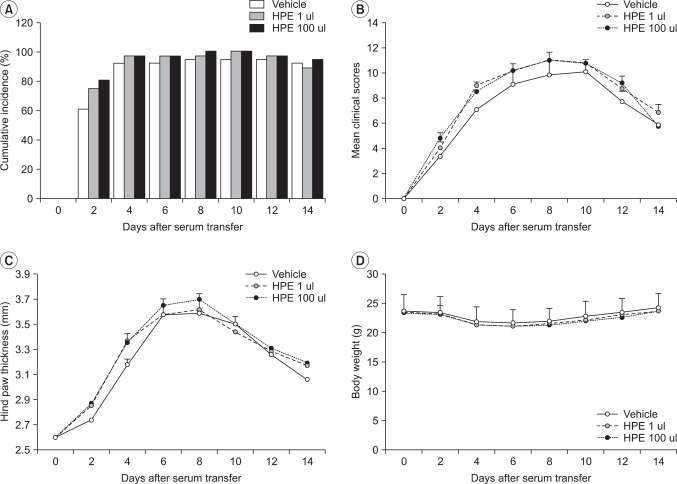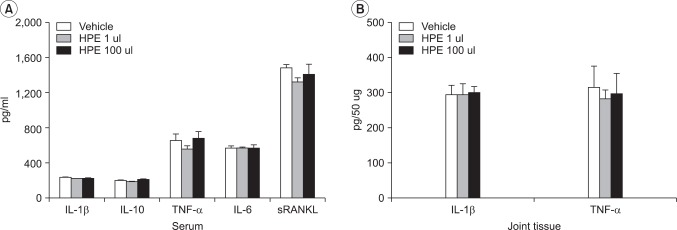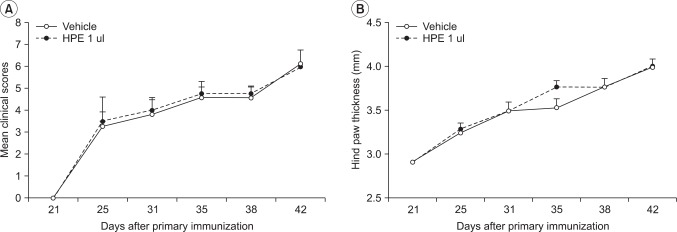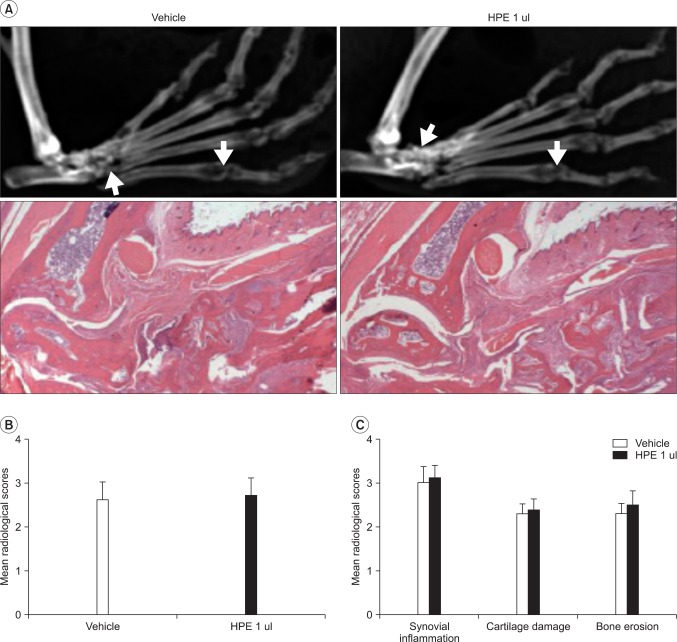Ann Rehabil Med.
2012 Apr;36(2):197-206. 10.5535/arm.2012.36.2.197.
The Effect of Human Placental Extract on Rheumatoid Arthritis in an Animal Model
- Affiliations
-
- 1Department of Rehabilitation Medicine, Gyeongsang National University College of Medicine, Jinju 660-702, Korea. hsshin@nongae.gsnu.ac.kr
- 2Department of Internal Medicine, Gyeongsang National University College of Medicine, Jinju 660-702, Korea.
- 3Department of Rehabilitation Medicine, Daegu Bohun Hospital, Daegu 704-802, Korea.
- KMID: 2266757
- DOI: http://doi.org/10.5535/arm.2012.36.2.197
Abstract
OBJECTIVE
To assess the efficacy of human placental extract (HPE) in an animal model of rheumatoid arthritis (RA). METHOD: We used (i) KRN C57BL/6 TCR transgenic x NOD mice (KBx/N) serum transfer arthritis and (ii) collagen-induced arthritis (CIA) mice to evaluate the effi cacy of HPE (1 ul or 100 ul, intra-peritoneal, three times per week) on RA. Incidence, severity of arthritis, and hind-paw thickness were quantifi ed. Joint destruction was analyzed using modifi ed mammographic imaging. Histopathological analysis for inflammation, cartilage, and osteoclasts was performed using Hematoxylin-eosin (H-E), safranin-O, and tartrate-resistant acidic phosphatase (TRAP). ELISAs were used for detection of various cytokines in serum and joint tissue.
RESULTS
There were no significant differences in incidence of arthritis, clinical scores of arthritis, and hind-paw thickness between HPE-treated and vehicle-treated groups for up to 2 weeks in the KBx/N serum transfer arthritis model. Histopathological analysis also showed no differences 2 weeks after treatment. Levels of TNF-alpha, IL-1beta, IL-6, IL-10, and RANKL in serum and joint tissues were similar in all groups. Furthermore, there were no differences in clinical, radiological, and histological parameters between HPE-treated and vehicle-treated group for 3 weeks in the CIA model.
CONCLUSION
Systemic treatment with HPE has no beneficial effects on arthritis in animal models of RA. Therefore, indiscreet use of HPE in RA should be forbidden.
MeSH Terms
-
Animals
Arthritis
Arthritis, Experimental
Arthritis, Rheumatoid
Cartilage
Cytokines
Enzyme-Linked Immunosorbent Assay
Humans
Incidence
Inflammation
Interleukin-10
Interleukin-6
Joints
Mice
Mice, Inbred NOD
Models, Animal
Osteoclasts
Tumor Necrosis Factor-alpha
Cytokines
Interleukin-10
Interleukin-6
Tumor Necrosis Factor-alpha
Figure
Reference
-
1. Lee ES. Analysis about consumers use of human placental injection and development of public relations technique. 2010. Korea food and drug administration.2. Sim CU. The placenta therapy. 2005. 1st ed. Seoul: MD World;p. 31.3. Park NJ. Safety, efficacy and limitations of medical use of placental extract. J Korean Med Assoc. 2005; 48:1013–1021.
Article4. Firestein GS. Evolving concepts of rheumatoid arthritis. Nature. 2003; 423:356–361. PMID: 12748655.
Article5. Huh J, Suh MS, Park SJ, Lim YK, Shin JH, Chung HY, Cho BC, Park JW. The effect of placenta extract on proliferation and differentiation of human chondrocytes. J Korean Soc Plast Reconstr Surg. 2006; 33:616–620.6. Kim JK, Kim TH, Park SW, Kim HY, Kim S, Lee S, Lee SM. Protective effects of human placenta extract on cartilage degradation in experimental osteoarthritis. Biol Pharm Bull. 2010; 33:1004–1010. PMID: 20522967.
Article7. Yeom MJ, Lee HC, Kim GH, Shim I, Lee HJ, Hahm DH. Therapeutic effects of Hominis placenta injection into an acupuncture point on the inflammatory responses in subchondral bone region of adjuvant-induced polyarthritic rat. Biol Pharm Bull. 2003; 26:1472–1477. PMID: 14519957.8. Combe B, Cosso B, Clot J, Bonneau M, Sany J. Human placenta-eluted gammaglobulins in immunomodulating treatment of rheumatoid arthritis. Am J Med. 1985; 78:920–928. PMID: 2409794.
Article9. Sany J, Clot J, Bonneau M, Andary M. Immunomodulating effect of human placenta-eluted gamma globulins in rheumatoid arthritis. Arthritis Rheum. 1982; 25:17–24. PMID: 7066033.
Article10. Lu J, Kasama T, Kobayashi K, Yoda Y, Shiozawa F, Hanyuda M, Negishi M, Ide H, Adachi M. Vascular endothelial growth factor expression and regulation of murine collagen-induced arthritis. J Immunol. 2000; 164:5922–5927. PMID: 10820274.
Article11. Mould AW, Tonks ID, Cahill MM, Pettit AR, Thomas R, Hayward NK, Kay GF. Vegfb gene knockout mice display reduced pathology and synovial angiogenesis in both antigen-induced and collagen-induced models of arthritis. Arthritis Rheum. 2003; 48:2660–2669. PMID: 13130487.
Article12. Luttun A, Tjwa M, Moons L, Wu Y, Angelillo-Scherrer A, Liao F, Nagy A, Hooper A, Priller J, Klerck B, et al. Revascularization of ischemic tissues by PIGF treatment, and inhibition of tumor angiogenesis, arthritis and atherosclerosis by anti-Flt1. Nat Med. 2002; 8:831–840. PMID: 12091877.13. Yoo SA, Yoon HJ, Kim HS, Chae CB, De Falco S, Cho CS, Kim WU. Role of placenta growth factor and its receptor flt-1 in rheumatoid inflammation: a link between angiogenesis and inflammation. Arthritis Rheum. 2009; 60:345–354. PMID: 19180491.
Article14. Kong MH, Lee EJ, Lee SY, Cho SJ, Hong YS, Park SB. Effect of human placental extract on menopausal symptoms, fatigue, and risk factors for cardiovascular disease in middle-aged Korean women. Menopause. 2008; 15:296–303. PMID: 18090035.
Article15. Park YR, Kim SR, Jeon GH, Kim SH, Chae HD, Kim CH, Suh CS, Lee BS, Choi H, Park HM, et al. Effect and Safety of Human Placental Extract on Menopausal Symptoms. J Korean Soc Menopause. 2009; 15:178–185.16. Sur TK, Biswas TK, Ali L, Mukherjee B. Anti-inflammatory and anti-platelet aggregation activity of human placental extract. Acta Pharmacol Sin. 2003; 24:187–192. PMID: 12546729.17. Banerjee KK, Bishayee A, Chatterjee M. Anti-inflammatory effect of human placental extract: a biochemical mechanistic approach. Riv Eur Sci Med Farmacol. 1992; 14:361–366. PMID: 1308603.
- Full Text Links
- Actions
-
Cited
- CITED
-
- Close
- Share
- Similar articles
-
- Experimental Animal Models for Rheumatoid Arthritis: Methods and Applications
- The use of animal models in rheumatoid arthritis research
- The Effect of Placental Extract on the Expression of Tyrosinase, TRP-1 and TRP-2 in SK30 Melanoma Cells
- Lessons for the pathogenesis of rheumatoid arthritis acquired from experimental animal models
- Differences in anti-type II Collegen antibody titers Among Degenerative Arthritis, Rheumatoid Arthritis and Control Groups






